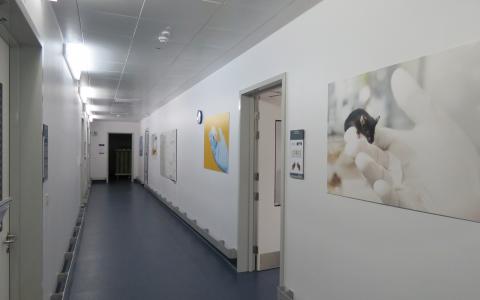
Nurturing a culture of care at SWC
By Hyewon Kim
“We’re all animal people here at the Neurobiological Research Facility (NRF),” says Jamie Redden, Standards & Licensing Officer and Home Office Liaison Contact (HOLC) at SWC. “A culture of care makes sure that animal welfare is strictly protected throughout the institute, but this culture also extends to the NRF staff and researchers themselves, to make sure their mental and emotional wellbeing is prioritised.”
In the past two years, technicians in biomedical research institutes around the world have had to brave the pandemic as essential workers to take care of laboratory animals. The need for animals’ cages to be changed, food resupplied, and post-op conditions monitored has remained throughout work-from-home guidance and emergence of Covid variants.
Lifting up 3Rs accomplishments
Throughout changing regulations, a culture of care at SWC has persisted. The 3Rs – replacement, reduction, refinement – are the guiding principles developed over 50 years ago that still drive us today to minimise use of animals and provide the best possible conditions for animals under care.
In the upcoming SWC/GCNU (Gatsby Computational Neuroscience Unit) 3Rs Awards, we celebrate the accomplishment of NRF staff and researchers who dedicated their time and energy to ensure that the 3Rs were creatively and resourcefully followed. The awards reflect a Centre-wide commitment to have a healthy questioning mindset to the status quo in animal research. It is also a chance to witness a cross-departmental culture of care. “It was amazing to see the community of researchers and professional staff like Fabrication Laboratories come together, without blinders on, and recognise the bigger picture that they’re a part of,” says Jamie.
“This is an establishment-wide commitment. We want to make sure people constantly maintain a critical open-mindedness to how research is done, to question whether the 3Rs can be constantly incorporated,” says Eleni Amaniti, Head of the NRF.
The 3Rs awards also provide a chance to personally recognise members of a lab. “It was great to see Group Leaders nominate their own PhD students,” says Eleni. “This shows a degree of appreciation for the quality of the culture of care, regardless of the results of the science.”
“The amount of thought that the NRF puts into animal welfare at SWC is remarkable,” comments Spencer Wilson, PhD Student in the Murray lab. “An event like the 3Rs awards reminds researchers to pause and explicitly think whether more could be done to respect each of the 3Rs in the context of their experiment.”
Practicing the 3Rs in experiments
Spencer began his PhD planning to use mice as animal models for his project, and has now fully transitioned to using only human subjects for his experiments, a prime example of ‘replacement’ in the 3Rs.
The project of Peter Vincent, PhD Student in the Akrami lab, is another example of using animal models only after the theoretical paradigm has been sufficiently refined in human subjects. “The NRF team has been great. They are very patient and thorough with their training. At first I found it challenging getting used to handling animals, and the different requirements when working with mice versus rats, but the NRF team have provided lots of guidance,” shares Peter.
“In other branches of science like cancer research, you often see replacement of animal use by use of cell cultures, for example,” says Eleni. “Here at SWC, we are committed to understanding how the brain generates complex and flexible behaviours. And that often calls for animal use.”
In the past few years, the use of rodents in research at SWC has enabled our understanding of the organisation, function, and plasticity of sensory brain circuits; cellular and network mechanisms of defensive behaviours; molecular and neural mechanisms of social behaviours; and more.
“For animal behaviour to be properly studied, researchers cannot afford to have animals that are not fit. We take our responsibility to care for these animals extremely seriously,” says Eleni.
All that said, there is no need to recreate the wheel. “If there is a previous study that’s been conducted to research a certain 3Rs practice, we will implement that,” shares Tina O’Mahony, NRF Operations Manager and 5-year-veteran at SWC. With 33 years of animal care under her belt, Tina knows how crucial it is for a research institute to adopt and systematise the training process that allows researchers to conduct high-quality research while at the same time caring for animals in accordance with Animal Welfare Ethical Review Body (AWERB) and Home Office guidelines.
Contributing to animal welfare beyond SWC
In addition to cultivating a high standard for the 3Rs within the institute, the NRF is also involved in the National Centre for the Replacement Refinement & Reduction of Animals in Research (NC3R) CRACK IT Challenge. The CRACK IT Challenges provide means for industry, academia, and small and medium-sized enterprises to collaborate with the goal of innovating 3Rs practices.
Janet Watson, HOLC & AWERB Chair at SWC, introduced Eleni to this possibility of helping with the Mouse MApp Challenge as a sponsor.
“We have resources to provide the organisers with annotated images of mice to help them come up with an algorithm that allows researchers to objectively, not subjectively, assess facial expressions and body conditions of mice so that any level of pain could be detected readily,” says Eleni. “This objective criterion can be developed through machine learning techniques.”
Making use of such objective criteria for assessing mouse welfare would diminish the uncertainty involved in traditional methods. The final product will be an app that automatically scores the condition of a mouse and reduces the time needed for staff to be trained.
Fortifying a culture of care
This external momentum is encouraging the SWC team to set their eyes on the big picture while not losing sight of the importance of extending the culture of care to animal carers themselves.
The pandemic years at SWC have shown that when this care extends to the entire institute, it ceases to be solely a set of rules to be adhered to, but becomes a wider invitation to the community for small, proactive, and persistent change. “The whole space needs to be safe,” says Jamie. Continuing to be aware of the evolving nature of a culture of care sparks conversations around what can be done to take care of the wellbeing of all those involved.

